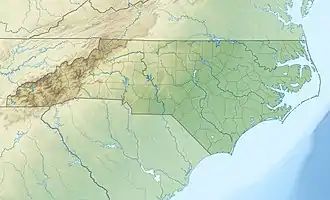Richland Creek (Deep River tributary, Randolph)
Richland Creek is a 15.00 mi (24.14 km) long 4th order tributary to the Deep River in Randolph County, North Carolina.
| Richland Creek Tributary to Deep River | |
|---|---|
 Location of Richland Creek mouth  Richland Creek (Deep River tributary, Randolph) (the United States) | |
| Location | |
| Country | United States |
| State | North Carolina |
| County | Randolph |
| Physical characteristics | |
| Source | confluence of North and South Prong Richland Creek |
| • location | about 0.25 miles northeast of Harveys Mountain |
| • coordinates | 35°38′39″N 079°46′39″W[1] |
| • elevation | 573 ft (175 m)[2] |
| Mouth | Deep River |
• location | about 1 mile northwest of Cheeks, North Carolina |
• coordinates | 35°36′34″N 079°36′26″W[1] |
• elevation | 351 ft (107 m)[2] |
| Length | 15.00 mi (24.14 km)[3] |
| Basin size | 66.06 square miles (171.1 km2)[4] |
| Discharge | |
| • location | Deep River |
| • average | 73.18 cu ft/s (2.072 m3/s) at mouth with Deep River[4] |
| Basin features | |
| Progression | southeast |
| River system | Deep River |
| Tributaries | |
| • left | North Prong Tantrough Branch Vestal Creek Squirrel Creek |
| • right | South Prong Panther Creek Bachelor Creek |
| Bridges | Old Cox Road, Old Humble Mill Road, Fairview Farm Road, Old NC 13, Kemp Mill Road, Little Beane Store Road, Picketts Mill Road, Erect Road, Riverside Road |
Course
Richland Creek is formed at the confluence of North and South Prong about 0.25 miles northeast of Harveys Mountain in Randolph County, North Carolina and then flows southeasterly to join the Deep River about 1 mile northwest of Cheeks, North Carolina.[2]
Watershed
Richland Creek drains 66.06 square miles (171.1 km2) of area, receives about 47.1 in/year of precipitation, and has a wetness index of 387.93 and is about 58% forested.[4]
See also
References
- "GNIS Detail - Richland Creek". geonames.usgs.gov. US Geological Survey. Retrieved 26 August 2020.
- "Richland Creek Topo Map in Randolph". TopoZone. Locality, LLC. Retrieved 26 August 2020.
- "ArcGIS Web Application". epa.maps.arcgis.com. US EPA. Retrieved 26 August 2020.
- "Richland Creek Watershed Report". US EPA Geoviewer. US EPA. Retrieved 26 August 2020.
This article is issued from Wikipedia. The text is licensed under Creative Commons - Attribution - Sharealike. Additional terms may apply for the media files.